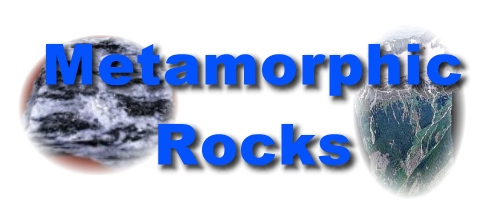Metamorphic Rock Identification
The term metamorphism means to change. Most of us think of the metamorphosis that occurs when a caterpillar becomes a butterfly. While not as dramatic, similar changes can occur in rocks. Rocks will alter their form and appearance to suit new conditions Unfortunately, metamorphism is a slow process that occurs deep within the Earth. We cannot directly observe the process, but we can see the end result, metamorphic rocks.
METAMORPHIC ROCKS
Metamorphic rocks result from mineralogical and structural adjustments of solid rocks to physical and chemical conditions differing from those under which the rocks originally formed. Changes produced by surface conditions such as compaction are usually excluded. The most important agents of metamorphism are temperature, and pressure. Equally as significant are changes in chemical environment that result in chemical recrystallization where a mineral assemblage becomes out of equilibrium due to temperature and pressure changes and a new mineral assemblage forms.
Three types of metamorphism may occur depending on the relative effect of mechanical and chemical changes. Dynamic metamorphism, or cataclasis, results mainly from mechanical deformation with little long-term temperature change. Textures produced by such adjustments range from breccias composed of angular, shattered rock fragments to very fine-grained, granulated or powdered rocks with obvious foliation and lineation termed mylonites. Contact metamorphism occurs primarily as a consequence of increases in temperature where differential stress is minor. A common phenomenon is the effect produced adjacent to igneous intrusions where several metamorphic zones represented by changing mineral assemblages reflect the temperature gradient from the high-temperature intrusion to the low-temperature host rocks; these zones are concentric to the intrusion. Because the volume affected is small, the pressure is near constant. Resulting rocks have equidimensional grains because of a lack of stress and are usually fine-grained due to the short duration of metamorphism. Regional metamorphism results from the general increase of temperature and pressure over a large area. Grades or intensities of metamorphism are represented by different mineral assemblages. Regional metamorphism can be subdivided into different pressure-temperature conditions based on observed sequences of mineral assemblages. It may include an extreme condition, where partial melting occurs, called anatexis.
Other types of metamorphism can occur. They are retrograde metamorphism, the response of mineral assemblages to decreasing temperature and pressure; metasomatism, the metamorphism that includes the addition or subtraction of components from the original assemblage; poly-metamorphism, the effect of more than one metamorphic event; and hydrothermal metamorphism, the changes that occur in the presence of water at high temperature and pressure which affect the resulting mineralogy and rate of reaction.
TYPES OF METAMORPHISM
To more fully understand metamorphic rocks and metamorphic processes is necessary to briefly discuss the various types of metamorphism. This may seem like a simple task, but unfortunately, there is no general agreement among scientists upon how many different types of metamorphism occur in nature. For our purposes we will discuss only the three most common and leave the controversy to others! To go to a discussion of each type click on the links in the list below.
TEXTURE AND CLASSIFICATION
In order to classify metamorphic rocks, it is also necessary to take of the subjects of texture and classification schemes. If you have completed the igneous rock exercise you might note that these discussion topics are similar with one exception. We also discussed the Minerals of Igneous Rocks, there is no such discussion of metamorphic minerals. This does not mean mineralogy of metamorphic rocks is not an important topic, rather the number of metamorphic minerals is too large to discuss in an introductory exercise. Fortunately, it is necessary to recognize only a few common minerals to name most metamorphic rocks. You have seen these minerals if you completed the minerals exercise and in some cases again in igneous rocks.
Now you are ready to identify some common metamorphic rocks. Let's get started!

|

